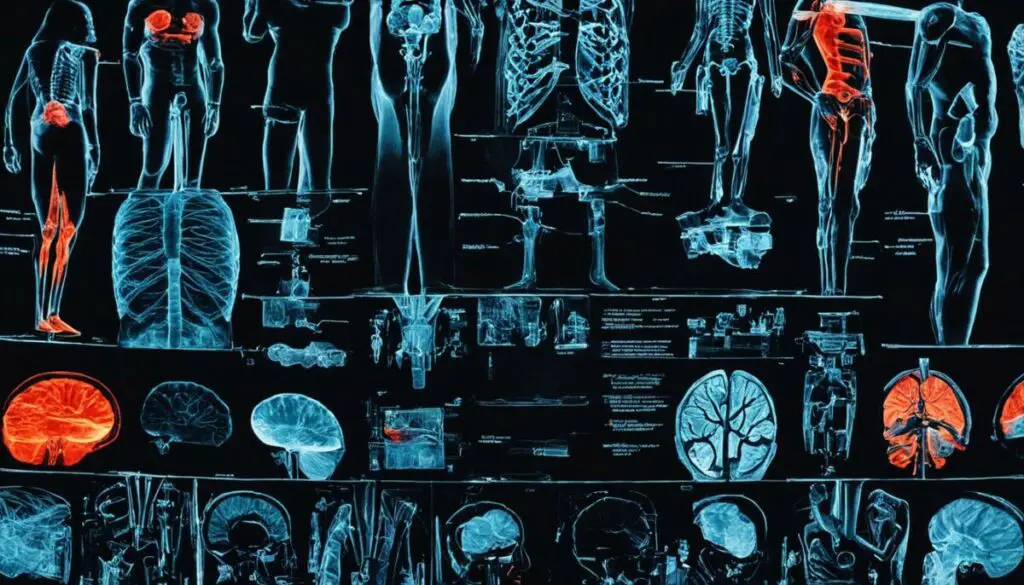Last Updated on 4 months by Francis
When it comes to understanding the different types of electromagnetic radiation, it’s essential to compare the wavelengths of infrared radiation and ultraviolet radiation. These two forms of energy exist on opposite ends of the electromagnetic spectrum, each with its unique characteristics and applications.
Infrared radiation is known for its longer wavelengths, while ultraviolet radiation has shorter wavelengths. This fundamental difference plays a significant role in how these types of radiation interact with their surroundings and the potential applications they offer.
In this article, we will explore the distinctive attributes of infrared and ultraviolet radiation, delve into their respective applications, and highlight the potential hazards associated with each type. By the end, you’ll have a clear understanding of the intriguing world of infrared and ultraviolet radiation and how they differ in the electromagnetic spectrum.
Contents
Key Takeaways:
- Infrared radiation has longer wavelengths than ultraviolet radiation.
- Infrared radiation is widely used in night vision, tracking, heating and cooling, meteorology, and astronomy.
- Ultraviolet radiation is used in fluorescent lighting, imaging technologies, some skincare treatments, and space exploration.
- Prolonged exposure to high levels of infrared radiation can damage the eyes, while overexposure to ultraviolet radiation can harm the skin and lead to skin cancer.
- Understanding the differences between infrared and ultraviolet radiation can help in making informed decisions regarding their applications and potential risks.
The Discovery of Infrared and Ultraviolet

In 1800, the German-born British astronomer William Herschel made a groundbreaking discovery that would change our understanding of light and heat. Herschel was conducting experiments on the behavior of different colors of light when he decided to measure the temperature beyond the red part of the visible spectrum.
Using a prism to split sunlight into its various colors, Herschel placed thermometers at different points along the spectrum. Expecting to find the highest temperatures near the red end, he was surprised to discover that the temperature was highest beyond the red light, where there was no visible light present.
Herschel concluded that there must be a form of radiation that is not visible to the human eye, which he called “infrared” (meaning “beyond red”). This discovery challenged the prevailing belief that light was solely responsible for heating objects and led to a fundamental shift in our understanding of the electromagnetic spectrum.
Infrared radiation extends beyond the visible spectrum and consists of longer wavelengths that are felt as heat rather than seen as light.
The following year, in 1801, German chemist Johann Wilhelm Ritter made another significant discovery. Ritter was investigating the effects of sunlight on different substances when he observed that silver chloride paper darkened more rapidly beyond the violet part of the spectrum.
Ritter hypothesized that there must be another type of radiation with wavelengths shorter than violet light. He named this radiation “ultraviolet” (meaning “beyond violet”). Ritter’s observations marked the discovery of ultraviolet radiation, which also expanded our understanding of the electromagnetic spectrum.
Ultraviolet radiation possesses shorter wavelengths than visible light and has unique properties that make it distinct from both infrared and visible radiation.
These groundbreaking discoveries by Herschel and Ritter laid the groundwork for the further exploration and understanding of infrared and ultraviolet radiation. They opened up new fields of research and countless applications in various industries, from astronomy to medicine.
Characteristics of Infrared Radiation

Infrared radiation, a part of the electromagnetic spectrum, possesses unique characteristics that set it apart from other forms of radiation. Understanding these characteristics is crucial to comprehend the applications and significance of infrared radiation.
Infrared radiation falls on the low-frequency end of the electromagnetic spectrum. It is characterized by its wavelengths, which range from 780nm to 1mm. The frequency of infrared radiation ranges from 300Ghz to 400THz, while its energy level varies between 1.2meV and 1.7eV.
The longer wavelengths of infrared radiation allow it to interact with and detect heat sources. This property makes it invaluable in applications where heat detection and imaging are required. By detecting the infrared radiation emitted by objects, infrared sensors and cameras can provide valuable insights into temperatures and thermal patterns.
Infrared radiation’s ability to interact with heat sources makes it vital in various industries, including:
- Thermography and non-destructive testing
- Manufacturing and assembly line quality control
- Energy auditing and weatherization
- Medical diagnosis and monitoring
- Surveillance and security systems
- Scientific research and astronomy
Furthermore, the shorter frequency range of infrared radiation allows for efficient transmission through the atmosphere, making it suitable for wireless communication technologies and remote controls. The versatility and practicality of infrared radiation have resulted in its extensive use across various industries and fields.
| Characteristics | Values |
|---|---|
| Wavelength Range | 780nm – 1mm |
| Frequency Range | 300Ghz – 400THz |
| Energy Level Range | 1.2meV – 1.7eV |
Applications of Infrared Radiation

Infrared radiation has numerous applications across various industries and fields, thanks to its unique ability to detect heat. Let’s explore some of the key applications:
Night Vision:
Infrared radiation is extensively used in night vision goggles and cameras. By detecting the heat emitted by objects, these devices enable enhanced visibility in low-light or dark environments, allowing for improved surveillance, navigation, and military operations.
Tracking Systems:
Infrared tracking systems are employed in various scenarios, including security systems, wildlife monitoring, and automotive applications. By detecting the infrared radiation emitted by individuals or objects, these systems enable accurate location tracking and monitoring.
Heating and Cooling:
Infrared radiation plays a crucial role in heating and cooling applications. Infrared heaters use radiation to directly heat objects or surfaces, making them energy-efficient and effective for localized heating. Infrared cooling, on the other hand, leverages the unique thermal properties of certain materials to achieve cooling effects without traditional refrigeration methods.
Communications:
Infrared radiation is also used in various wireless communication technologies, such as remote control systems and infrared data transmission. Infrared signals can be used to transmit data, control devices, and establish short-range communication links in applications ranging from TV remotes to security systems.
Meteorology:
Meteorologists utilize infrared radiation to gather valuable information about the atmosphere. Infrared sensors and satellites help measure temperature distributions, detect cloud formations, monitor weather patterns, and predict severe weather events. This data plays a critical role in weather forecasting and climate studies.
Astronomy:
Astronomers rely on infrared radiation to explore the universe and gather data about celestial bodies. Infrared telescopes, such as the Hubble Space Telescope, capture infrared light to reveal details about distant galaxies, stars, and cosmic phenomena. Infrared astronomy allows scientists to study objects that are otherwise difficult to observe using visible light.
In addition to these applications, infrared thermography is widely used for inspecting buildings, electrical systems, and industrial equipment. It enables the detection of thermal anomalies and provides valuable insights into the functioning and efficiency of various systems.
Overall, the diverse applications of infrared radiation highlight its significance in various industries and scientific fields, where its unique capabilities for heat detection and radiative properties prove invaluable.
| Application | Description |
|---|---|
| Night Vision | Enables enhanced visibility in low-light or dark environments for surveillance, navigation, and military purposes. |
| Tracking Systems | Accurate location tracking and monitoring for security, wildlife, and automotive applications. |
| Heating and Cooling | Efficient localized heating and innovative cooling methods without traditional refrigeration. |
| Communications | Wireless communication technologies, including remote control systems and infrared data transmission. |
| Meteorology | Atmospheric temperature measurements, cloud detection, and severe weather prediction. |
| Astronomy | Studying distant galaxies, stars, and cosmic phenomena that are difficult to observe with visible light. |
Dangers of Infrared Radiation

While infrared radiation is generally safe, it is important to be aware of its potential dangers, particularly when it comes to high-frequency infrared radiation. Prolonged exposure to high levels of infrared radiation can be harmful to the eyes and may cause damage to the retinas, potentially leading to vision problems and even blindness.
Infrared radiation can have thermal effects on the eyes, which means that it can generate heat and cause tissue damage. The eyes are particularly vulnerable to this type of radiation because they lack the ability to effectively dissipate heat. This is why it is crucial to take necessary safety precautions when working with high-frequency infrared radiation sources, such as lasers or industrial equipment.
However, it is essential to note that when infrared radiation is encountered in regular amounts, such as in everyday environments or through commonly used devices, it is considered relatively safe. For example, exposure to the sun’s infrared radiation is generally not a cause for concern, as the levels are typically within a safe range. Nonetheless, it is important to be mindful of the potential risks and take appropriate measures to protect yourself, especially during activities that involve prolonged or intense exposure to infrared radiation.
When working in environments where exposure to infrared radiation is common, wearing appropriate protective eyewear can significantly reduce the risk of eye damage. These specially designed glasses are equipped with filters that block harmful wavelengths of infrared radiation while allowing visible light to pass through.
“Prolonged exposure to high levels of infrared radiation can cause damage to the retinas and potentially lead to blindness.”
Characteristics of Ultraviolet Radiation

Ultraviolet (UV) radiation is a type of electromagnetic radiation that falls within the shorter wavelengths of the ultraviolet spectrum. It is characterized by its unique properties and higher energy levels compared to visible light. Understanding the characteristics of UV radiation is essential in recognizing its role in various fields.
Wavelengths: Ultraviolet radiation has wavelengths ranging from 400nm to 180nm, which are shorter than the wavelengths of visible light. These shorter wavelengths allow UV radiation to interact with matter in distinct ways, making it useful for specific applications.
Frequencies: UV radiation has frequencies ranging from 800THz to 30PHz, indicating the number of oscillations or cycles it undergoes per second. These high frequencies contribute to the high-energy nature of UV radiation.
Energy Levels: With energy levels ranging from 3eV to 124eV, ultraviolet radiation possesses greater energy than visible light. This higher energy enables UV radiation to interact with atoms and molecules more vigorously, resulting in unique chemical reactions and biological effects.
To illustrate the characteristics of ultraviolet radiation, consider the following table:
| Characteristic | Range |
|---|---|
| Wavelengths | 400nm – 180nm |
| Frequencies | 800THz – 30PHz |
| Energy Levels | 3eV – 124eV |
In summary, ultraviolet radiation is characterized by its shorter wavelengths, higher frequencies, and greater energy levels compared to visible light. These unique properties contribute to its diverse applications in areas such as photography, sterilization, and scientific research. Understanding the characteristics of UV radiation allows us to harness its potential benefits while remaining aware of the associated hazards.
Applications of Ultraviolet Radiation

Ultraviolet radiation offers numerous applications across various industries, making it a valuable tool in different fields. Let’s explore some of its key applications:
- Fluorescent Lighting: Ultraviolet radiation is extensively used in fluorescent lighting systems. When UV radiation interacts with phosphor coatings inside fluorescent bulbs, it causes them to emit visible light. This process makes fluorescent lighting more energy-efficient compared to traditional incandescent bulbs.
- Imaging Technologies: UV radiation plays a crucial role in various imaging technologies, including ultraviolet photography and ultraviolet spectroscopy. These techniques use specific wavelengths of UV radiation to capture unique images and measure the chemical composition of different materials.
- Skin Treatment: UV radiation is utilized in certain forms of skin treatment. In phototherapy, controlled exposure to specific wavelengths of UV light helps treat skin conditions such as psoriasis, vitiligo, and eczema. UV radiation is also used in some cosmetic procedures, such as collagen stimulation and acne treatment.
“Ultraviolet radiation has proven to be extremely useful in diverse applications, from lighting to medical treatments. Its ability to interact with various materials and substances opens up possibilities for continuous advancements in technology and healthcare.” – Dr. Sarah Thompson, Radiologist
In addition to these applications, ultraviolet radiation is also employed in space exploration. The Hubble Telescope, for example, uses UV detectors to capture images and gather data about celestial objects and phenomena.
Now, let’s take a closer look at the various forms of skin treatment that utilize UV radiation:
| Treatment | Description |
|---|---|
| Phototherapy | Controlled exposure to specific wavelengths of UV light to treat skin conditions like psoriasis, vitiligo, and eczema. |
| Collagen Stimulation | High-energy UV radiation used to stimulate collagen production, helping reduce the appearance of wrinkles and improve skin elasticity. |
| Acne Treatment | Targeted UV radiation used in medical settings to treat acne by killing the bacteria responsible for breakouts. |
As we can see, ultraviolet radiation plays a significant role in various applications, ranging from lighting and imaging to skin treatment and space exploration. Its unique properties and ability to interact with matter continue to drive advancements in technology and scientific research.
Dangers of Ultraviolet Radiation

Ultraviolet (UV) radiation poses significant risks to both the eyes and skin. Overexposure to UV radiation can lead to various adverse effects, including sunburn, damage to collagen, and the development of skin cancer.
When the skin is exposed to excessive UV radiation, it can become red, painful, and in extreme cases, blistered. This condition is commonly known as sunburn.
Long-term exposure to UV radiation can result in collagen damage, leading to premature aging and the development of wrinkles.
“Collagen damage caused by UV radiation is a major concern”
Perhaps the most alarming danger associated with UV radiation is its link to skin cancer. Prolonged and frequent exposure to UV radiation increases the risk of developing various types of skin cancer, including basal cell carcinoma, squamous cell carcinoma, and malignant melanoma.
Malignant melanoma, in particular, is a highly aggressive form of skin cancer that is strongly correlated with UV radiation exposure. It can spread quickly to other parts of the body and is responsible for a significant number of skin cancer-related deaths.
The Role of UV Radiation in Skin Cancer
UV radiation can cause DNA damage in skin cells, leading to mutations and the uncontrolled growth of cells, which is a hallmark of cancer development. The skin’s ability to repair this DNA damage may become overwhelmed with repeated exposure, increasing the risk of cancerous growth.
| Type of Skin Cancer | Description |
|---|---|
| Basal Cell Carcinoma | The most common type of skin cancer, usually appearing as a red, scaly patch or a flesh-colored, pearly bump. |
| Squamous Cell Carcinoma | The second most common type, often presenting as a firm, red nodule or a flat sore that crusts or bleeds. |
| Malignant Melanoma | The most dangerous form, characterized by the abnormal growth of pigment cells. It may appear as an asymmetrical mole with irregular borders and various colors. |
Protecting your skin from the harmful effects of UV radiation is crucial. Wearing broad-spectrum sunscreen with a high SPF, seeking shade during peak sun hours, and wearing protective clothing can help reduce the risk of UV damage.
By taking proactive measures to limit exposure to UV radiation, you can minimize the dangers it poses to your eyes and skin. Stay safe and be diligent in protecting yourself from the harmful effects of UV radiation.
Infrared vs. Ultraviolet: Comparing the Two
When comparing infrared and ultraviolet radiation, it becomes apparent that these two types of electromagnetic radiation have distinct characteristics, applications, and potential hazards.
Infrared radiation is commonly associated with heat sources and has a wide range of applications in various industries. Its longer wavelengths, ranging from 780nm to 1mm, enable it to interact with and detect heat sources effectively. This makes infrared radiation invaluable in applications such as night vision, tracking systems, heating and cooling devices, communication technology, meteorology, and even astronomy.
Ultraviolet radiation, on the other hand, has shorter wavelengths than visible light and is part of the electromagnetic spectrum. With wavelengths ranging from 400nm to 180nm, ultraviolet radiation possesses higher energy levels, making it useful in certain applications. It is employed in fluorescent lighting, imaging technologies, and specific forms of skin treatment. Ultraviolet radiation also plays a crucial role in space exploration through its utilization in the Hubble Telescope.
“Infrared radiation is often associated with heat sources and has a wide range of applications in various industries. Ultraviolet radiation, on the other hand, has limited applications due to its potential harm to the eyes and skin.”
While both types of radiation have their respective applications and benefits, it is important to note the hazards associated with each.
Although infrared radiation is generally considered safe, prolonged exposure to high-frequency infrared radiation can be harmful to the eyes. It is crucial to practice caution and minimize direct exposure to excessive heat sources, which emit intense infrared radiation. Ensuring appropriate eye protection can mitigate any potential risks.
On the other hand, ultraviolet radiation poses more significant risks. Overexposure to UV radiation can cause sunburn, damage collagen fibers in the skin, and even lead to various forms of skin cancer. Skin protection measures such as using SPF-enhanced sunscreen and wearing protective clothing are essential precautions to safeguard against these hazards.
To summarize, infrared and ultraviolet radiation differ in terms of their characteristics, applications, and potential hazards. Infrared radiation finds extensive use in various industries due to its association with heat sources, while ultraviolet radiation has more limited applications due to its risks to eye and skin health. Understanding these differences is crucial for utilizing these types of radiation effectively while prioritizing safety.
Conclusion
In conclusion, the comparison between infrared and ultraviolet radiation reveals significant differences in their wavelengths. Infrared radiation has longer wavelengths compared to ultraviolet radiation. These differences in wavelength play a crucial role in their respective applications and potential hazards.
While both types of radiation have diverse applications, infrared radiation is more commonly used due to its association with heat sources. It finds extensive use in night vision technology, tracking systems, communication devices, meteorology, and astronomy. Additionally, its ability to detect heat makes it invaluable in heating and cooling systems, as well as in the field of infrared thermography for inspection purposes.
On the other hand, ultraviolet radiation has limited applications due to its potential harm to the eyes and skin. It is utilized in fluorescent lighting, imaging technologies, and certain forms of skin treatment. However, overexposure to ultraviolet radiation can lead to sunburn, collagen damage, and an increased risk of skin cancer.
By understanding the differences between infrared and ultraviolet radiation, we can appreciate their unique characteristics and make informed decisions regarding their applications and potential hazards. While infrared radiation dominates in terms of usage, both types play significant roles in various fields and contribute to our understanding of the electromagnetic spectrum.
FAQ
Are infrared wavelengths longer than ultraviolet waves?
Yes, infrared wavelengths are longer than ultraviolet waves. Infrared radiation has longer wavelengths ranging from 780nm to 1mm, while ultraviolet radiation has shorter wavelengths ranging from 400nm to 180nm.
What is the electromagnetic spectrum?
The electromagnetic spectrum is the range of all possible electromagnetic radiation, which includes infrared radiation, ultraviolet radiation, visible light, and more.
What are the characteristics of infrared radiation?
Infrared radiation has wavelengths ranging from 780nm to 1mm, frequencies between 300Ghz and 400THz, and energy levels from 1.2meV to 1.7eV.
What are the applications of infrared radiation?
Infrared radiation is used in night vision goggles, tracking systems, heating and cooling devices, communication technology, meteorology, astronomy, and infrared thermography for building and electrical system inspections.
Are there any dangers associated with infrared radiation?
While infrared radiation is generally safe, prolonged exposure to high-frequency infrared radiation can be harmful to the eyes and potentially lead to blindness. Regular amounts of exposure are considered relatively safe.
What are the characteristics of ultraviolet radiation?
Ultraviolet radiation has wavelengths ranging from 400nm to 180nm, frequencies between 800THz and 30PHz, and energy levels from 3eV to 124eV.
What are the applications of ultraviolet radiation?
Ultraviolet radiation is used in fluorescent lighting, imaging technologies, some forms of skin treatment, and the Hubble Telescope for space exploration.
Are there any dangers associated with ultraviolet radiation?
Yes, overexposure to ultraviolet radiation can cause sunburn, collagen damage, and various forms of skin cancer, including malignant melanoma.
How do infrared and ultraviolet radiation compare?
Infrared radiation has longer wavelengths and is commonly associated with heat sources, resulting in its wider range of applications. Ultraviolet radiation has shorter wavelengths and is limited in applications due to its potential harm to the eyes and skin.




.jpg)




